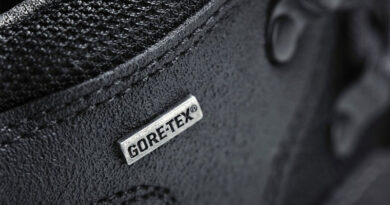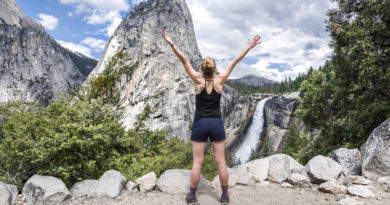What to Wear Hiking in 40-Degree Weather?
Choosing the right clothes for a 40°F hike is essential because it will be cold outside. So what should you wear when the weather is that cold? Well, you need to wear clothes in a traditional 3-layer system. Keep in mind there’s no single solution to everybody’s situation because the temperature will go up and down, the humidity will be different, the wind, the quality of your clothes, etc. So, I will explain things in general but it’ll get you on the right track. One universal point to consider is never to wear cotton. This is because cotton absorbs water and dries slowly, which makes you cold and uncomfortable.
Before we begin, it’s vital to understand why the layering system is so important. If you’re sitting around a campfire, you’re not doing much, and it is 40 degrees Fahrenheit, you’re going to need a lot of clothing to stay warm. But if it’s zero degrees and you’re hiking up a mountain, your body is going to be generating heat and you will be staying warmer to prevent sweating, you will take off certain layers. In other words, you can take off layers when you start to feel hot. This makes the layering system a convenient way to wear clothes for the outdoors.
Base Layer
The first layer you need to wear is your base layer. It is the layer that touches your skin and the purpose of this layer is to keep you dry. It wicks away moisture from your body and keeps you nice and dry. Make sure your base layer provides a close fit because you want as much fabric touching your skin as possible. Base layers are usually made of synthetic materials like a polyester blend. Your base layer can be a short or long sleeve t-shirt. This layer is not meant to keep you warm.
A good example of base layers is the Patagonia Capilene Crew Top. It is made of recycled polyester that is bluesign approved. This means the fabric is safe for the environment, workers, and customers. The Capilene base layer also provides a little warmth and it is very breathable. It dries out quickly and it doesn’t retain odor. The fabric feels soft against the skin and the internal diamond-grid pattern rests lightly on the skin to trap warmth. The fabric also has stretch and it moves with providing good freedom of movement. Finally, the seams are Flatlock seams and they don’t rub against your skin.
Mid-Layer
Next to the base layer is the mid-layer. This layer actually keeps you warm. This can vary in thickness and weight depending on the weather condition. For hiking in 40 degrees weather, you need a mid-weight wool sweater that provides a good amount of insulation. You can also combine your wool sweater with a fleece hoody if you get cold easily. One nice feature to have with your mid layer is thumb holes. That way, it prevents drafts and cold air from being blown up your sleeves. This layer will take all of the moisture away from your base layer so it could be evaporated.
My favorite mid-layer option is the Patagonia Nano-Air. It’s got synthetic insulation and it is very comfortable to wear. This mid-layer also provides excellent breathability and weather performance. One of the good things about this mid-layer is its versatility. You can wear it as a mid-layer in the winter or wear it as an outer layer during the shoulder season or on warm winter days. Also, the stretchy and breathable fabric makes this mid-layer a good option for backcountry skiers and climbers. You can also use it around town and it will be your go-to winter jacket.
Outer Layer or Jacket
If you use a fleece hoody for insulation, chances are, you will still feel wind cutting through the fleece fabric. This is because fleece is not windproof and you need to protect yourself from that chilly wind. In terms of outer layers, you’ve got two options; a lightweight shell and a full fledge hiking jacket. If you are not expecting rain, you probably don’t need a waterproof jacket or shell. Instead, you just need an outer layer that can protect you from the wind. For this purpose, you can either go for a lightweight shell or a full fledge hiking jacket. The difference is that the shell jacket will not provide any additional warmth while the hiking jacket will have some built-in insulation.
Arc’teryx Beta LT jacket is my favorite outer layer when it comes to the traditional 3-layer system. This jacket doesn’t provide a huge amount of insulation but it protects you from moisture and performs really well in the mountains. However, it keeps you somewhat warm by trapping warm air inside. It adds a completely waterproof and windproof layer to the outside. Keep in mind that your outer layer should also provide a good amount of breathability. Otherwise, you will be sweating heavily while working hard. You don’t want moisture building up inside.
An Additional Layer of Insulation
There’s one other layer that you should carry in your backpack and this is your insulating layer. There’s a fine line between this layer and a mid-layer but this is a kind of layer that I always carry in my backpack. It is just an additional mid-layer in your pack for emergency use. You need this layer when you stop for lunch, you have an injury, or when you have to be stationary for a longer period of time. Your body loses heat very quickly when you are in a stationary position. This is when you need that additional layer of insulation in addition to your mid-layer. Also, when you climb up the mountain, it is going to get colder and you may just need a little bit more insulation.
Gloves
Now let’s talk a little about hands. As long as you are staying active, walking around, and working around camp, you can keep your hands nice and warm with just a pair of simple knit gloves. They do not offer lots of insulation but if you are staying busy, they will keep your hands warm. Let’s say when you are sleeping in your tent and it’s super cold, you may need a pair of warmer gloves. That way, your knit gloves will act like a base layer, and the upper layer gloves will retain the heat. Also, look for insulation and waterproofness in the gloves.
Beanie
If you are hiking around and it’s not too windy, you can wear a thin beanie. But let’s say the temperature drops and it’s windy, you may need a very thick beanie. That way, it will block more wind and retain more heat. It also covers your entire head and ears. Now, if it’s really windy and cold, you can combine your beanie with a scarf. It will protect the back of your neck so that when the wind is blowing, it doesn’t chill you down. Also, if your face is getting cold, you can cover it with this scarf. Protecting your neck and face from the wind will keep you even warmer.
Hiking Bottom
When it comes to legs, you have three possible layering options. You have your thermals, which also act as a base layer plus they provide warmth to your legs. Thermals are also known as long johns or long underwear. They come in a number of different thickness options and weights. There are tons of different brands out there so research them and you will find some amazing options. If it is above 40 degrees, you probably don’t need thermals because it can become too hot. In this case, you only need a good pair of hiking pants designed for cold weather. If it is too windy or rainy, you can put a waterproof shell over your pants to stay dry.
Socks
Going down to the feet, you need a thick and warm pair of socks especially if it is too chilly. Wool is my favorite material when it comes to hiking socks. Merino wool is just fine because it is not too itchy. Some wool can be itchy for some people but merino wool works just fine for most people. In super cold conditions, you can combine a thin pair of socks with a thick pair for maximum warmth. When wearing multiple pairs of socks, make sure you are not cutting your circulation to your feet. If you do so, your feet will be even colder.
Shoes
There are multiple types of shoes available to wear. These include insulated, non-insulated, waterproof, non-waterproof, etc. It really is up to you what you have. If you are doubling your socks, make sure your feet fit comfortably in your shoes and it is not restricting any circulation. When it comes to shoes for hiking, my preference is the waterproof pair of hiking boots. That’s what I find works well for me. When it comes to waterproofing in the boots, Gore-Tex is the best lining available. It releases the most moisture and it also releases the most heat. In other words, it keeps your feet dry while still remaining breathable.




